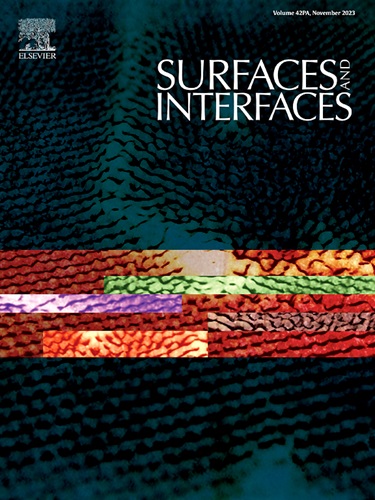Chromium-containing wastewater effectively removed by TiO2 microsphere of different sizes through a green pathway
IF 5.7
2区 材料科学
Q2 CHEMISTRY, PHYSICAL
引用次数: 0
Abstract
Efficient and environmental-friendly removal of heavy metal Cr(VI) from water sources is a key challenge in current environmental management. Photocatalysis provides a feasible and ecofriendly solution for the elimination of heavy metal ions. In this study, Anatase TiO2 microspheres (TMS) with abundant porous structure as well as excellent dispersion and uniform size were constructed through a sol-gel method after calcination by utilizing titanium sulfate as precursor. And the particle size can be regulated in the range of 0.6–4 μm by adjusting the oil-water ratio. The morphology was observed by scanning electron microscope (SEM) and the microstructure was studied by transmission electron microscope (TEM). Moreover, the specific surface area was determined to be about 200–260 m2/g by Brunauer-Emmett-Teller (BET) method with the N2 adsorption-desorption test. Besides, the existence state and phase composition were studied by X-ray diffraction (XRD), Raman spectroscopy (Raman) and X-ray photo-electron spectroscopy (XPS). Then, the most likely formation mechanism is proposed, namely the temperature-induced active aggregation of nanoparticles and subsequent combination of major particles. Afterwards, the optical properties of TMS were characterized by UV–Vis diffuse reflectance spectroscopy (UV–Vis DRS). The photocatalytic degradation efficiency of Cr(VI) (100 ml, 20 mg/L) reached 99 % after 100 min with 10 mg of TMS and remain stable in four cycles, which indicates that TMS is an superb choice for the removal of wastewater containing Cr(VI). In addition, the photocatalytic degradation of Cr(VI) of different scavengers and different pH values was studied. Based on the above analysis, the potential photocatalytic degradation mechanism of Cr(VI) by TMS under simulated sunlight illumination was proposed. Therefore, this study provides an efficient strategy for the synthesis of microscale spherical TiO2 and paves a new path for its potential application fields in wastewater treatment of containing Cr(VI).
不同粒径TiO2微球通过绿色途径有效去除含铬废水
高效、环保地去除水源中的重金属Cr(VI)是当前环境管理的一个关键挑战。光催化为重金属离子的去除提供了一种可行且环保的解决方案。本研究以硫酸钛为前驱体,通过溶胶-凝胶法制备了多孔结构丰富、分散性好、粒径均匀的锐钛矿型TiO2微球(TMS)。通过调节油水比,可将颗粒粒径控制在0.6 ~ 4 μm范围内。采用扫描电镜(SEM)观察其形貌,透射电镜(TEM)研究其微观结构。通过N2吸附-解吸试验,采用BET法测定了其比表面积约为200 ~ 260 m2/g。利用x射线衍射(XRD)、拉曼光谱(Raman)和x射线光电子能谱(XPS)研究了材料的存在态和相组成。然后,提出了最可能的形成机制,即温度诱导的纳米颗粒的活性聚集和随后的主要颗粒的结合。随后,利用UV-Vis漫反射光谱(UV-Vis DRS)表征了TMS的光学性质。10 mg TMS对100 ml、20 mg/L Cr(VI)的光催化降解效率在100 min后达到99%,且在4个循环中保持稳定,表明TMS是去除含Cr(VI)废水的理想选择。此外,还研究了不同清除剂和不同pH值对光催化降解Cr(VI)的影响。在此基础上,提出了模拟阳光照射下TMS光催化降解Cr(VI)的潜在机理。因此,本研究为微尺度球形TiO2的合成提供了一种有效的策略,并为其在含Cr(VI)废水处理中的潜在应用领域铺平了新的道路。
本文章由计算机程序翻译,如有差异,请以英文原文为准。
求助全文
约1分钟内获得全文
求助全文
来源期刊

Surfaces and Interfaces
Chemistry-General Chemistry
CiteScore
8.50
自引率
6.50%
发文量
753
审稿时长
35 days
期刊介绍:
The aim of the journal is to provide a respectful outlet for ''sound science'' papers in all research areas on surfaces and interfaces. We define sound science papers as papers that describe new and well-executed research, but that do not necessarily provide brand new insights or are merely a description of research results.
Surfaces and Interfaces publishes research papers in all fields of surface science which may not always find the right home on first submission to our Elsevier sister journals (Applied Surface, Surface and Coatings Technology, Thin Solid Films)
 求助内容:
求助内容: 应助结果提醒方式:
应助结果提醒方式:


